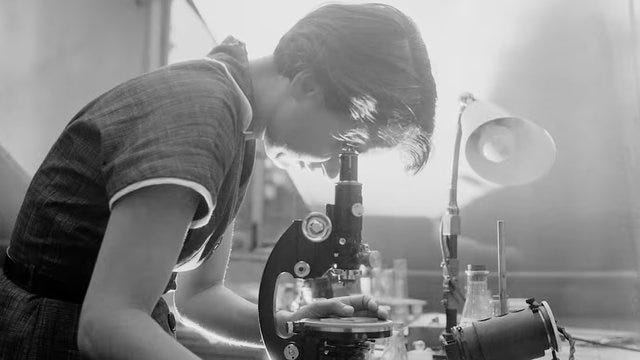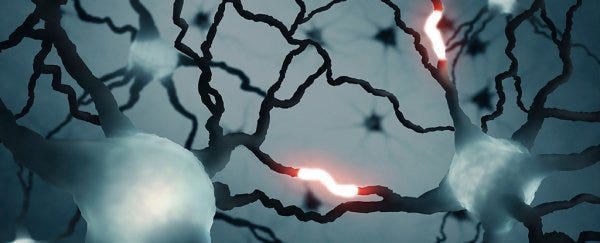Sci-Ed Update 264
New twist in the double-helix discovery, still uncertain?, male death rate is high, is grade inflation a thing?, students can use a nudge, a new kind of action potential?, can brown fat kill cancer?
Update
Yep, I’m still here! And still dealing with uncertainty. But at least…here’s another issue of The A&P Professor Science & Education Updates.
Rosalind Franklin knew DNA was a helix before Watson and Crick, unpublished material reveals
A new paper based on long-lost documents confirms that DNA discoverer Rosalind Franklin should be credited for discovering the double helix.

In 1962, scientists James Watson, Francis Crick and Maurice Wilkins received the Nobel Prize in Medicine for discovering the double helix structure of DNA. However, it has long been believed that the trio never would've made this significant discovery if they hadn't stolen data from Rosalind Franklin, a British chemist who was the first person to determine that DNA had a helical structure, similar to a spiral staircase.
Now, a previously overlooked letter and never-published news article, both penned in 1953, confirm that Franklin played as big a role in the discovery of DNA structure as the other Nobel winners, though she died before the prize was awarded, making her ineligible.
Still, she probably freely shared her knowledge with Watson and Crick, rather than having her X-ray images used without her knowledge, as Watson himself implied, according to a new paper published online on April 27 in the journal Nature.
"We wanted to set the record straight," Nathaniel Comfort(opens in new tab), a professor of the history of medicine at Johns Hopkins University in Baltimore and co-author of the paper, told Live Science.
"[Our research] presents a better picture of Franklin," Comfort said. "Before, she was reduced from being a scientist to a tragic heroine and had no agency in the story. We wanted to reinstate her as a fully fleshed scientist."
Read more→ AandP.info/4l3
The Uncertainty Effect with Michelle Lazarus
Are we still uncertain? That’s okay! Let’s develop an attitude of curiosity and have an adventure, why don’t we?
It’s the newest episode… and the one everyone is talking about! Join me as I chat with Michelle Lazarus, the author of the new book The Uncertainty Effect: How to Survive and Thrive Through the Unexpected
To listen, click the player (if visible) or go to theAPprofessor.org/podcast-episode-135.html or listen wherever you listen to audio!
A silent crisis in men’s health gets worse
Across the life span -- from infancy to the teen years, midlife and old age -- boys and men are more likely to die than girls and women
A silent crisis in men’s health is shortening the life spans of fathers, husbands, brothers and sons.
For years, the conventional wisdom has been that a lack of sex-specific health research mainly hurts women and gender minorities. While those concerns are real, a closer look at longevity data tells a more complicated story.
Across the life span — from infancy to the teen years, midlife and old age — the risk of death at every age is higher for boys and men than for girls and women.
The result is a growing longevity gap between men and women. In the United States, life expectancy in 2021 was 79.1 years for women and 73.2 years for men. That 5.9-year difference is the largest gap in a quarter-century. (The data aren’t parsed to include differences among nonbinary and trans people.)
“Men are advantaged in every aspect of our society, yet we have worse health outcomes for most of the things that will kill you,” said Derek Griffith, director of Georgetown University’s Center for Men’s Health Equity in the Racial Justice Institute.“We tend not to prioritize men’s health, but it needs unique attention, and it has implications for the rest of the family. It means other members of the family, including women and children, also suffer.”
The longevity gap between men and women is a global phenomenon, although sex differences and data on the ages of greatest risk vary around the world and are influenced by cultural norms, record keeping and geopolitical factors such as war, climate change and poverty.
Read more→ AandP.info/3lo
The Grade Inflation Conversation We’re Not Having
The good news is that [college] completion rates have been rising since the 1990s across almost all types of institutions (for-profits are the exception).
According to Department of Education data, 64 percent of students who began seeking a bachelor’s degree at a four-year institution in the fall of 2014 completed that degree at the same institution within six years. Still, rates vary greatly by institution: At Princeton, 98 percent of students graduate in six years; an hour or so up the road, at Bloomfield College, in New Jersey, that rate is just 33 percent. (Bloomfield is in the process of merging with Montclair State University.) To understand these trends, we analyzed three national data sources, and a clear trend emerged: College completion is trending upward.
What led to this trend? Our research was able to rule out several potential explanations. The trend was not explained by students changing enrollment patterns by attending colleges with higher graduation rates. It was not due to students performing better on standardized tests prior to starting college. Changes in student-to-faculty ratios and instructional expenditures also failed to explain the graduation-rate improvement, we found. At the same time, students were working more for wages while enrolled and were spending less time studying, which seemed unlikely to boost graduation rates. This left us with a puzzle. What else could explain the dramatic increase in graduation?
It boiled down, we found, to an increase in GPAs — yes, grade inflation. First-year GPAs increased from 2.44 to 2.65 for college students who graduated high school in 1992 compared to 2004. And the rise in GPAs was significant enough to account for the increase in graduation rates. But why are GPAs increasing in the first place?
Kevin Patton comment→ Read the whole article! There are some interesting points and counterpoints raised regarding grade inflation.
Read more→ AandP.info/v5q
Teaching: Could a few emails from you boost student success?
A little outreach goes a long way
Professors play a key role in students’ paths through college. But connecting with students and providing them with useful feedback is a big challenge for professors teaching very large classes.
A new paper offers some encouraging evidence that low-touch forms of outreach from an instructor can make a difference in how students, especially those from marginalized groups, view the course — and help improve their academic performance.
Read more→ AandP.info/mve
A First-of-Its-Kind Signal Has Been Detected in The Human Brain
Scientists have recently identified a unique form of cell messaging occurring in the human brain that's not been seen before.
Excitingly, the discovery hints that our brains might be even more powerful units of computation than we realized.
Kevin Patton comment→ Read the full article for a full explanation that adds another dimension to the story that you and I already tell about nerve signalling in our A&P course.
Read more→ AandP.info/9kf
Surrounding tumours with brown fat could starve them of nutrients
Tumours in mice had reduced growth after brown fat, which burns sugars and other fuel that tumours need to grow, was implanted nearby. Researchers used CRISPR gene editing to convert white fat, which can be collected via liposuction, into brown fat

Implanting brown fat around cancerous tumours could halve their size as the fat burns the fuel tumours need to grow. Although only tested in mice and human tissue to date, white fat could one day be extracted from people via liposuction and genetically engineered using the CRISPR technique to turn it into brown fat that then starves tumours of nutrients such as sugar.
Brown fat, mainly found in newborn humans and hibernating mammals, burns other fats and sugars to create heat. Adult humans, however, mostly have white fat, which stores these fuels for energy.
To assess whether brown fat could take these nutrients away from tumours, Nadav Ahituv at the University of California, San Francisco, and his colleagues used the CRISPR technique to increase the expression of a gene called UCP1 in human white fat, causing it to convert to engineered brown fat.
They then injected human breast, prostate or pancreatic cancer cells into mice to form tumours, before implanting either white fat or the engineered brown fat next to these tumours.
The tumours surrounded by brown fat grew to less than half the size of those surrounded by white fat.
Read more→ AandP.info/iia







